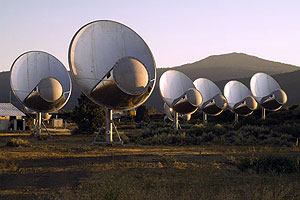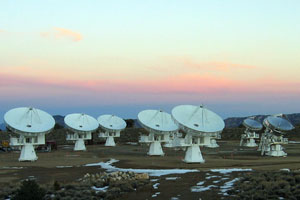 A few telescopes from the Allen Telescope ArrayIf you're at all like me, you spend a lot of time surfing the web pages of the astronomy departments in this country. Just the other day I was looking at the departments at Yale University, University of Michigan, University of Wisconsin, UC-Santa Barbara and UC-San Diego. Each of these places has a share in their own world-class instrument. Yale and Wisconsin have shares in optical telescopes on Kitt Peak, Michigan has a share in a large optical telescope in Chile, and the University of California departments all have a share of the Keck Observatory Keck Observatory in Hawai'i.
A few telescopes from the Allen Telescope ArrayIf you're at all like me, you spend a lot of time surfing the web pages of the astronomy departments in this country. Just the other day I was looking at the departments at Yale University, University of Michigan, University of Wisconsin, UC-Santa Barbara and UC-San Diego. Each of these places has a share in their own world-class instrument. Yale and Wisconsin have shares in optical telescopes on Kitt Peak, Michigan has a share in a large optical telescope in Chile, and the University of California departments all have a share of the Keck Observatory Keck Observatory in Hawai'i.
It is very common that a university shares time with other members of a consortium. The advantage of such an arrangement is that a department is guaranteed a certain number of nights to observe every year without having to foot the entire cost.
Being attached to UC-Berkeley for more than eight years, I am very familiar with their instruments. The three major observatories for the UC-Berkeley astronomy department are the Allen Telescope Array, the Keck Observatory, and the Combined Array for Reasearch in Millimeter-Wave Astronomy, or in our usual acronym vernacular CARMA. With these observatories, the Berkeley astronomers can probe three entirely different regions of the electromagnetic spectrum.
The Allen Telescope Array is designed for cm-wave observations from Hat Creek, CA, where I did most of my graduate thesis work. It wasn't actually there at the time, I was using a different instrument that has since been moved to Owens Valley to join the CARMA array. The Allen Telescope is funded in part by a not-so-anonymous founder of Microsoft. His interest is in using the instrument to look for broadcast from nearby aliens. What's fascinating about the design of these telescopes is that they can actually observe multiple targets at once. While looking for aliens around one star, the instrument can simultaneously point at another nearby region of the sky and study pulsars, active galactic nuclei, or anything else your heart desires. It's a great way to hedge your bets.
 Several of the 15 CARMA antennas.
Several of the 15 CARMA antennas.
Credit: Andrew A. West, U.C. Berkeley,
Radio Astronomy Lab.Moving up in the electromagnetic spectrum, the CARMA array is the union of a (CalTech instrument and a Berkeley-Illinois-Maryland instrument that is now in the mountains above Owens Valley. These telescopes are designed for observations in mm-wave region of the electromagnetic spectrum. There are quite a few molecular emission lines that can be observed at these wavelengths. These lines trace out the distribution of carbon monoxide and other compounds that are associated with star births. Among other projects, astronomers use these telescopes to map out regions of the Milky Way and other nearby galaxies that are forming huge new systems of stars.
